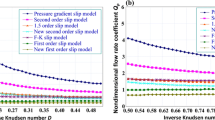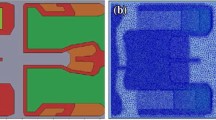Abstract
A numerical model for the simulation of slider flying characteristics and frequency response in helium-air gas mixtures has been developed. The dynamic flying characteristics of the slider are obtained by simultaneously solving the Reynolds equation and the slider equilibrium equations. The contact force, friction force and adhesive force at the slider/disk interface are investigated using a slider/disk contact model. Frequency analysis shows that the second pitch mode of the slider is shifted to a higher frequency with an increase in the percentage of helium.










Similar content being viewed by others
References
Aruga K, Suwa M, Shimizu K, Watanabe T (2007) A study on positioning error caused by flow induced vibration using helium-filled hard disk drives. IEEE Trans Magn 43(9):3750–3755
Bird GA (1994) Molecular gas dynamics and the direct simulation of gas flows. Oxford Univ Press, New York
Bouchard G, Talke FE (1986) Non-repeatable flutter of magnetic recording disks. IEEE Trans Magn 22(5):1019–1021
Chang WR, Etsion I, Bogy DB (1988) Static friction coefficient model for metallic rough surfaces. ASME J Tribol 110(1):57–63
Deoras SK, Talke FE (2004) Time–frequency analysis of slider dynamics and the effect of lubricant. ASME J Tribol 126(3):559–564
Hua W, Ng KK, Yu S, Zhou W, Myo KS (2012) Frequency analyses of air bearing slider in near contact and contact states. Tribol Lett 48(3):345–353
Kogut L, Etsion I (2004) A static friction model for elastic-plastic contacting rough surfaces. ASME J Tribol 126(1):34–40
Lemmon EW, Jacobsen RT, Penoncello SG, Friend DG (2000) Thermodynamic properties of air and mixtures of nitrogen, argon, and oxygen from 60 to 2000 K at pressures to 2000 MPa. J Phys Chem Ref Data 29:331–385
Lide DR (2009) CRC handbook of chemistry and physics, 89th edn. CRC, Boca Raton, Florida
Liu N, Zheng J, Bogy DB (2009) Thermal flying-height control sliders in hard disk drives filled with air-helium gas mixtures. Appl Phys Lett 95(21):213505–213507
Poling BE, Prausnitz JM, O’Connell JP (2001) The properties of gases and liquids, 5th edn. McGraw-Hill, New York
Salas PA, Talke FE (2013) Numerical simulation of thermal flying-height control sliders to dynamically minimize flying height variations. IEEE Trans Magn 49(4):1337–1342
Shimizu Y, Xu J, Kohira H, Kuroki K, Ono K (2011) Experimental study on slider dynamics during touchdown by using thermal flying-height control. Microsyst Technol 17(5–7):897–902
Shimizu Y, Xu J, Li J, Kohira H, Hashimoto K (2012) Effect of reduction of slider pitch-mode vibration on magnetic recording performance at low-clearance head-disk interface. Microsyst Technol 18(9–10):1597–1606
Song W, Salas PA, Ovcharenko A, Zheng H, Talke FE (2013a) Numerical investigation of slider dynamics induced by contacts with disk asperities. Microsyst Technol 19(9–10):1393–1399
Song W, Matthes L, Ovcharenko A, Knigge B, Talke FE (2013b) Experimental study of slider dynamics induced by contacts with disk asperities. Microsyst Technol 19(9–10):1369–1375
Suh AY, Polycarpou AA (2008) Adhesive contact modeling for sub-5-nm ultralow flying magnetic storage head-disk interfaces including roughness effects. J Appl Phys 97(10):104328–104338
Tanaka H, Yonemura S, Tokisue H (2001) Slider dynamics during continuous contact with textured and smooth disks in ultra low flying height. IEEE Trans Magn 37(2):906–911
Tang Z, Salas-Mendez PA, Talke FE (2014) Investigation of head/disk contacts in helium-air gas mixtures. Tribol Lett 54(3):279–286
Yang J, Tan CPH, Ong EH (2010) Thermal analysis of helium-filled enterprise disk drive. Microsyst Technol 16(10):1699–1704
Zeng QH, Bogy DB (1999) Experimental evaluation of stiffness and damping of slider-air bearings in hard disk drives. ASME J Tribol 121(1):102–107
Acknowledgments
We would like to thank Hanya-san, John Hogan and Ross Cuyler of NHK International Corporation for their interest and support of this work. Zhengqiang Tang was a visiting student at the University of California, San Diego (UCSD) at the time of this reserch project. He would like to thank the China Scholarship Council (CSC) and Prof. Frank E. Talke for financially supporting his Ph.D. studies at UCSD.
Author information
Authors and Affiliations
Corresponding author
Appendices
Appendix 1: Slider/disk contact model
The contact model implemented in this paper includes contact forces, friction forces, and adhesive forces. Following Kogut and Etsion (2004), contact and friction forces were modeled for the case of contact between a flat and a rough surface including elastic, elastic–plastic, and plastic deformations of surface asperities. Adhesive forces between two rough surfaces were calculated considering the presence of a thin lubricant film (Suh and Polycarpou 2008). Both of the above models were combined and implemented in the present head/disk contact model. For the sake of completeness, we define the various forces in this section based on Kogut and Etsion (2004) and Suh and Polycarpou (2008).
The dimensionless contact force is given by Kogut and Etsion (2004) as
where the superscript * denotes normalization with respect to σ (the standard deviation of surface heights); H is the hardness of the softer material; β is a roughness parameter (\(\beta = \sigma \eta R\)), where η is the area density of asperities and all asperities are assumed to have the same radius of curvature R); K(\(K = 0.454 + 0.41v\)) is the hardness coefficient and v is the Poisson’s ratio of the softer material (Chang et al. 1988); ω c is the critical interference at the inception of plastic deformation and d is the distance between the mean of the asperity heights and the smooth rigid flat.
In Eq. (A1), I b is a general form of the integrand
where \(z(z^{*} = z/\sigma )\) is the asperity height measured from the mean of the asperity heights, and \(\varphi^{*} (z^{*} )\) is the normalized Gaussian asperity height distribution
where σ s is the standard deviation of asperity heights defined by Suh and Polycarpou (2008)
The dimensionless friction force is given by Kogut and Etsion (2004) as
where I b is defined in Eq. (A2).
Finally, the dimensionless total adhesive force which accounts for the presence of a molecularly thin lubricant film of thickness t_l (mobile portion only) is given by Suh and Polycarpou (2008)
where Δγ is the energy of adhesion, J nc and \(J_{b}^{c}\) denote the contributions of non-contacting and contacting asperities, respectively, and J lc denotes the contribution of lubricated asperities in contact. The J-terms have the form:
In Eqs. (A7, A8, A9), ɛ is the intermolecular distance that is typically between 0.3 and 0.5 nm Kogut and Etsion (2004).
The dimensionless net adhesive force W * for rough surfaces is given by Suh and Polycarpou (2008) as
In Fig. 11, the adhesive force, contact force, friction force and net adhesive force are shown as a function of the separation between slider and disk (Tang et al. 2014). We observe that contact and friction forces become of importance at the slider/disk interface if the slider/disk separation decreases below 2.5 nm. These forces increase strongly as the separation between slider and disk decreases. At large spacing, the net adhesive force is an attractive force due to non-contacting asperities. This force becomes a repulsive force as the separation decreases further. Additional details for the implementation of the contact model can be found in Tang et al. (2014).
Adhesive, contact, friction and net adhesive forces as a function of separation between slider and disk (Tang et al. 2014)
Appendix 2: Physical properties of gas mixtures
Following the calculation in our previous paper (Tang et al. 2014), the density ρ m of the helium-air gas mixture was calculated using linear interpolation, i.e.
where, the subscript m denotes the helium-air gas mixture, α is the fraction of helium in the helium-air gas mixture; ρ is the density, and the subscripts H and A refer to helium and air, respectively.
The mean free path of the gas mixture was calculated using Bird’s method (Bird 1994), i.e.
where n is the number of molecules per unit volume; D H and D A are the molecular diameters for helium and air, respectively; M is the molecular weight; \(D_{HA} = (D_{H} + D_{A} )/2\).
The viscosity of the gas mixture was determined using Poling’s method (Poling et al. 2001), i.e.
with
In Eq. (A13), i represents HA (helium-air), H (helium), or A (air), respectively; \({\text{T}}_{\text{rH}} {\text{ = T/T}}_{\text{CH}}\), \({\text{T}}_{\text{rA}} {\text{ = T/T}}_{\text{CA}}\), \({\text{T}}_{\text{rHA}} { = }\left( {{\text{T/T}}_{\text{CH}} {\text{T}}_{\text{CA}} } \right)^{1/2}\); T is the gas temperature, while TCH and TCA are critical temperatures of helium and air, respectively. The parameters required in the equations are listed in Table 1, taken from Lide (2009) and Lemmon et al. (2000).
Rights and permissions
About this article
Cite this article
Tang, Z., Talke, F.E. Investigation of slider flying characteristics and frequency response in helium-air gas mixtures. Microsyst Technol 21, 2589–2596 (2015). https://doi.org/10.1007/s00542-015-2500-0
Received:
Accepted:
Published:
Issue Date:
DOI: https://doi.org/10.1007/s00542-015-2500-0





